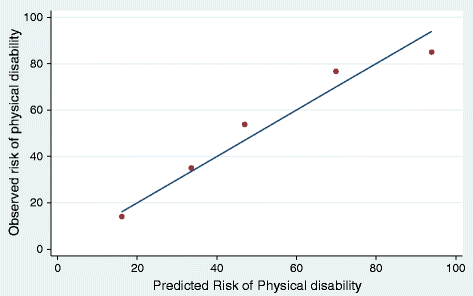Early prediction of new-onset physical disability after intensive care unit stay: a preliminary instrument
- PMID: 25079385
- PMCID: PMC4243809
- DOI: 10.1186/s13054-014-0455-7
Early prediction of new-onset physical disability after intensive care unit stay: a preliminary instrument
Abstract
Introduction: Many intensive care unit (ICU) survivors suffer from physical disability for months after ICU stay. There is no structured method to identify patients at risk for such problems. The purpose of the study was to develop a method for early in-ICU prediction of the patient's individual risk for new-onset physical disability two months after ICU stay.
Methods: In total, 23 potential predictors for physical disability were assessed before individual ICU discharge. Two months after ICU discharge, out of 232 eligible patients, 148 ICU survivors (64%) completed the activity of daily living (ADL) staircase questionnaire to determine new-onset physical disability.
Results: A total of 95% percent of patients had no ADL reduction prior to ICU admission. 47% (n = 69) of questionnaire responders suffered from worsened ADL. We identified four independent predictors for new-onset physical disability: Low educational level (odds ratio (OR) =6.8), impaired core stability (OR = 4.6), fractures (OR = 4.5) and ICU length of stay longer than 2 days (OR = 2.6). The predictors were included in a screening instrument. The regression coefficient of each predictor was transformed into a risk score. The sum of risk scores was related to a predicted probability for physical disability in the individual patient. The cross-validated area under receiver operating characteristics curve (AUC) for the screening instrument was 0.80.
Conclusions: Educational level is the single most important predictor for new-onset physical disability 2 months after ICU stay, followed by impaired core stability at ICU discharge, the presence of fractures and ICU stay longer than 2 days. A simple screening instrument based on these predictors can be used at ICU discharge to determine the risk for new-onset physical disability. This preliminary instrument may help clinicians to identify patients in need of support, but needs external validation prior to wider clinical use.
Figures
Comment in
-
Early identification of patients at risk of long-term critical illness-associated physical disability: is it possible?Crit Care. 2014 Nov 19;18(6):629. doi: 10.1186/s13054-014-0629-3. Crit Care. 2014. PMID: 25672518 Free PMC article.
-
Early sedation use in critically ill mechanically ventilated patients: when less is really more.Crit Care. 2014 Nov 10;18(6):600. doi: 10.1186/s13054-014-0600-3. Crit Care. 2014. PMID: 25673278 Free PMC article.
References
-
- Society of Critical Care Medicine: Critical Care Statistics. [http://www.sccm.org/Communications/Pages/CriticalCareStats.aspx]
-
- National Institute for Health and Clinical Excellence: Rehabilitation after critical illness. [http://guidance.nice.org.uk/CG83/NICEGuidance] - PubMed
-
- Svenska Intensivvårdsregistret - SIR: Riktlinje för PostIVA uppföljning. [http://www.icuregswe.org/sv/Riktlinjer/PostIVA-uppfoljning-20121/]
Publication types
MeSH terms
LinkOut - more resources
Full Text Sources
Other Literature Sources
Medical





